People Management - Assignment Sample
VerifiedAdded on 2021/06/18
|10
|2187
|36
AI Summary
Contribute Materials
Your contribution can guide someone’s learning journey. Share your
documents today.
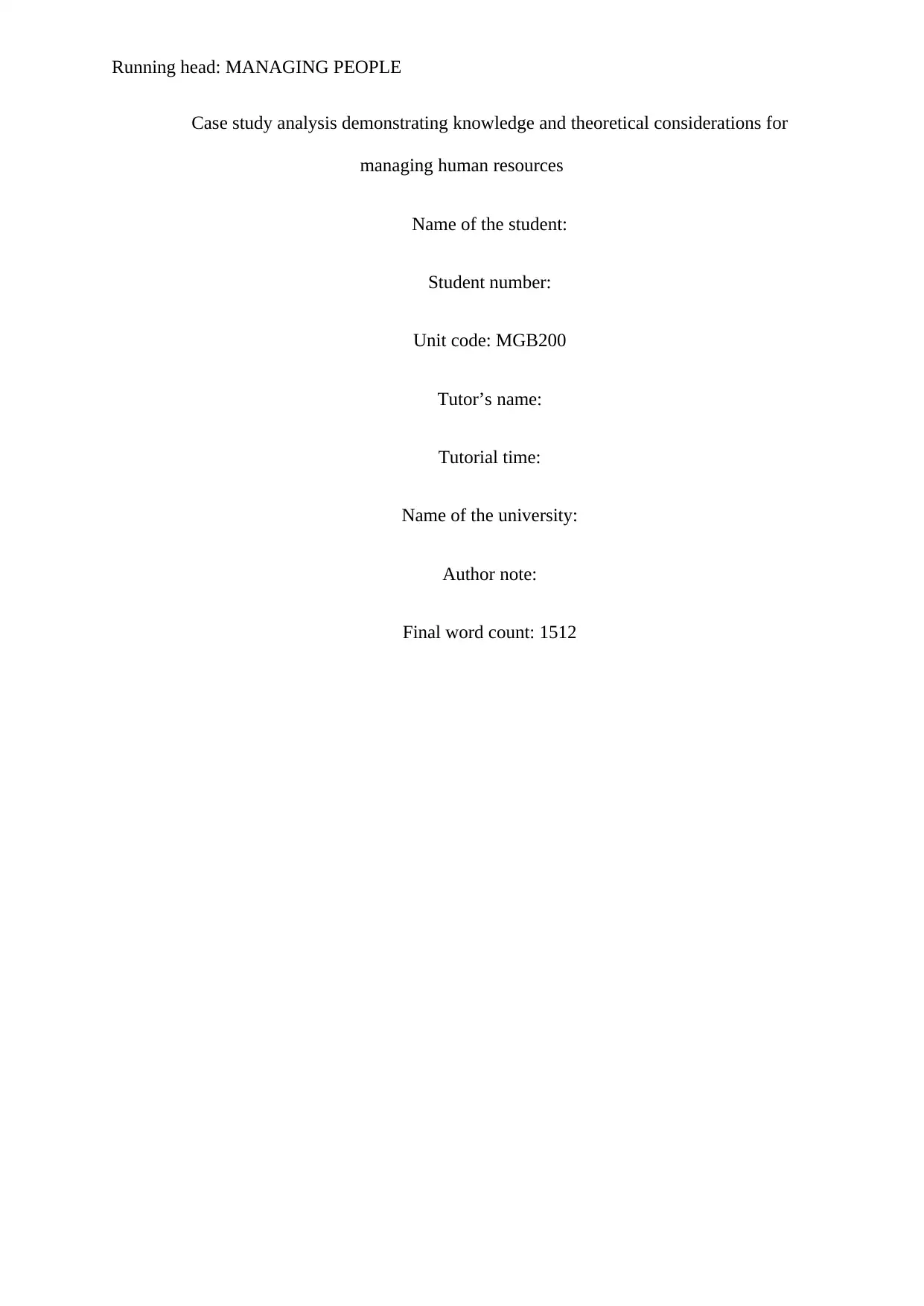
Running head: MANAGING PEOPLE
Case study analysis demonstrating knowledge and theoretical considerations for
managing human resources
Name of the student:
Student number:
Unit code: MGB200
Tutor’s name:
Tutorial time:
Name of the university:
Author note:
Final word count: 1512
Case study analysis demonstrating knowledge and theoretical considerations for
managing human resources
Name of the student:
Student number:
Unit code: MGB200
Tutor’s name:
Tutorial time:
Name of the university:
Author note:
Final word count: 1512
Secure Best Marks with AI Grader
Need help grading? Try our AI Grader for instant feedback on your assignments.
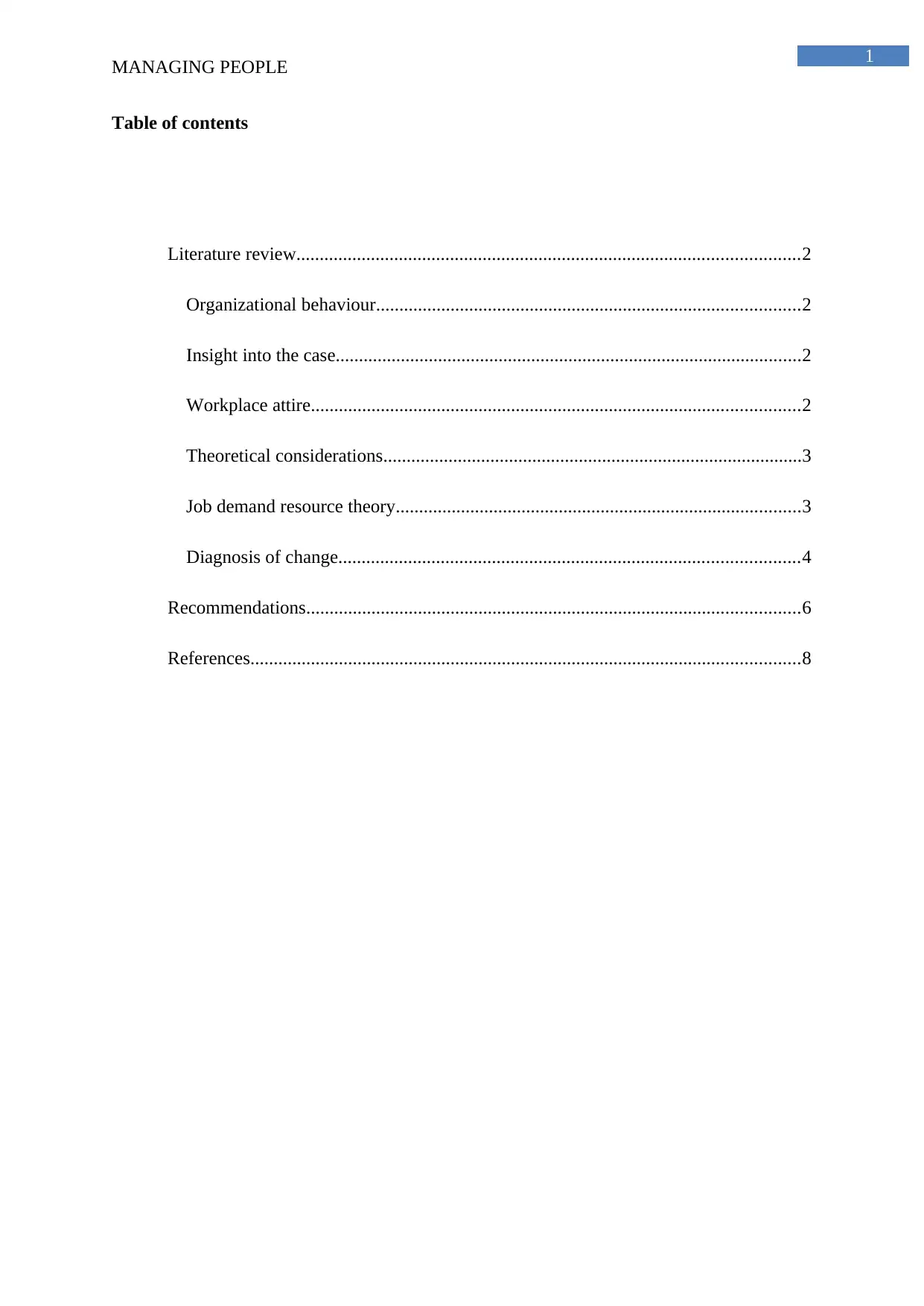
1
MANAGING PEOPLE
Table of contents
Literature review............................................................................................................2
Organizational behaviour...........................................................................................2
Insight into the case....................................................................................................2
Workplace attire.........................................................................................................2
Theoretical considerations..........................................................................................3
Job demand resource theory.......................................................................................3
Diagnosis of change...................................................................................................4
Recommendations..........................................................................................................6
References......................................................................................................................8
MANAGING PEOPLE
Table of contents
Literature review............................................................................................................2
Organizational behaviour...........................................................................................2
Insight into the case....................................................................................................2
Workplace attire.........................................................................................................2
Theoretical considerations..........................................................................................3
Job demand resource theory.......................................................................................3
Diagnosis of change...................................................................................................4
Recommendations..........................................................................................................6
References......................................................................................................................8
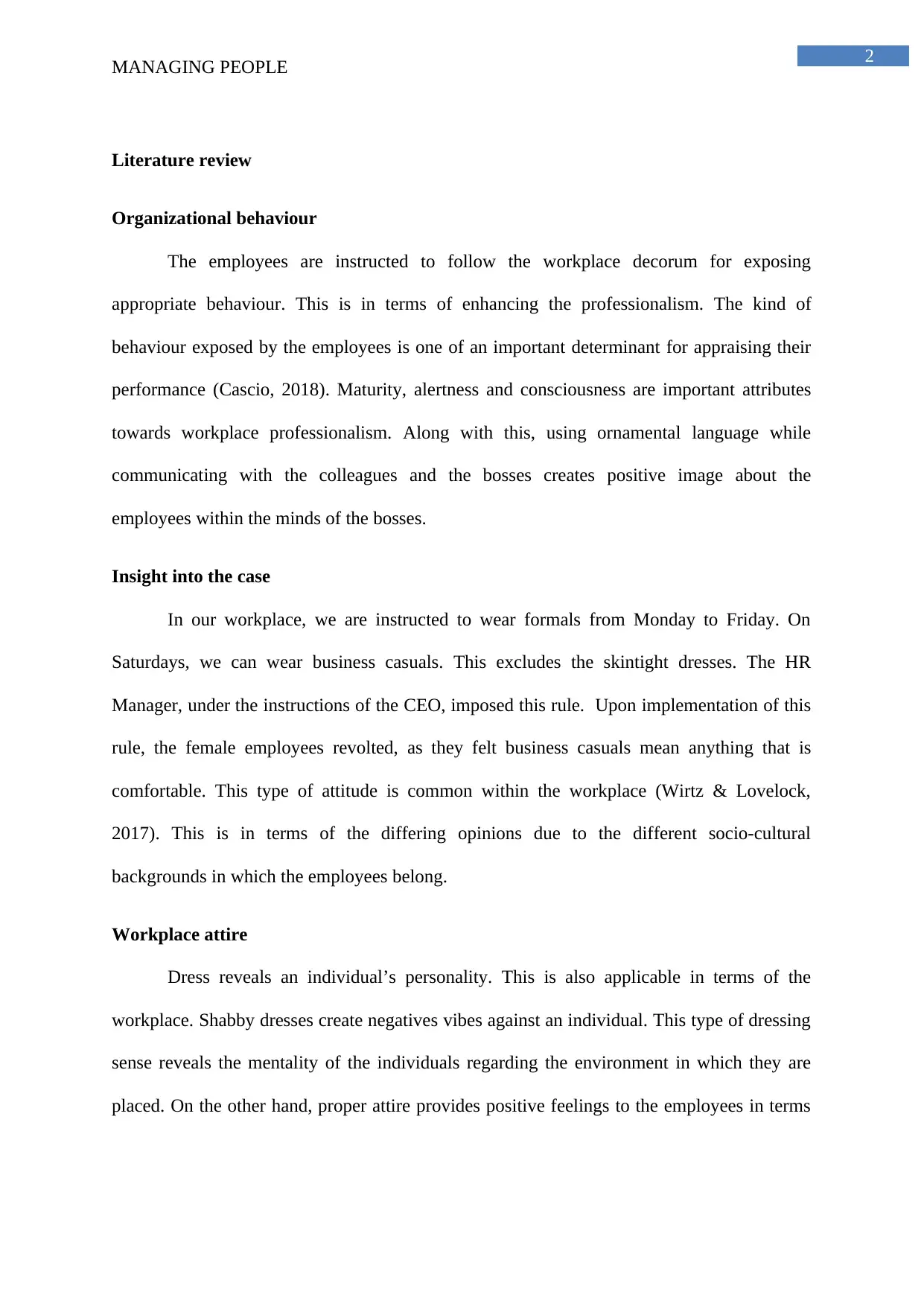
2
MANAGING PEOPLE
Literature review
Organizational behaviour
The employees are instructed to follow the workplace decorum for exposing
appropriate behaviour. This is in terms of enhancing the professionalism. The kind of
behaviour exposed by the employees is one of an important determinant for appraising their
performance (Cascio, 2018). Maturity, alertness and consciousness are important attributes
towards workplace professionalism. Along with this, using ornamental language while
communicating with the colleagues and the bosses creates positive image about the
employees within the minds of the bosses.
Insight into the case
In our workplace, we are instructed to wear formals from Monday to Friday. On
Saturdays, we can wear business casuals. This excludes the skintight dresses. The HR
Manager, under the instructions of the CEO, imposed this rule. Upon implementation of this
rule, the female employees revolted, as they felt business casuals mean anything that is
comfortable. This type of attitude is common within the workplace (Wirtz & Lovelock,
2017). This is in terms of the differing opinions due to the different socio-cultural
backgrounds in which the employees belong.
Workplace attire
Dress reveals an individual’s personality. This is also applicable in terms of the
workplace. Shabby dresses create negatives vibes against an individual. This type of dressing
sense reveals the mentality of the individuals regarding the environment in which they are
placed. On the other hand, proper attire provides positive feelings to the employees in terms
MANAGING PEOPLE
Literature review
Organizational behaviour
The employees are instructed to follow the workplace decorum for exposing
appropriate behaviour. This is in terms of enhancing the professionalism. The kind of
behaviour exposed by the employees is one of an important determinant for appraising their
performance (Cascio, 2018). Maturity, alertness and consciousness are important attributes
towards workplace professionalism. Along with this, using ornamental language while
communicating with the colleagues and the bosses creates positive image about the
employees within the minds of the bosses.
Insight into the case
In our workplace, we are instructed to wear formals from Monday to Friday. On
Saturdays, we can wear business casuals. This excludes the skintight dresses. The HR
Manager, under the instructions of the CEO, imposed this rule. Upon implementation of this
rule, the female employees revolted, as they felt business casuals mean anything that is
comfortable. This type of attitude is common within the workplace (Wirtz & Lovelock,
2017). This is in terms of the differing opinions due to the different socio-cultural
backgrounds in which the employees belong.
Workplace attire
Dress reveals an individual’s personality. This is also applicable in terms of the
workplace. Shabby dresses create negatives vibes against an individual. This type of dressing
sense reveals the mentality of the individuals regarding the environment in which they are
placed. On the other hand, proper attire provides positive feelings to the employees in terms
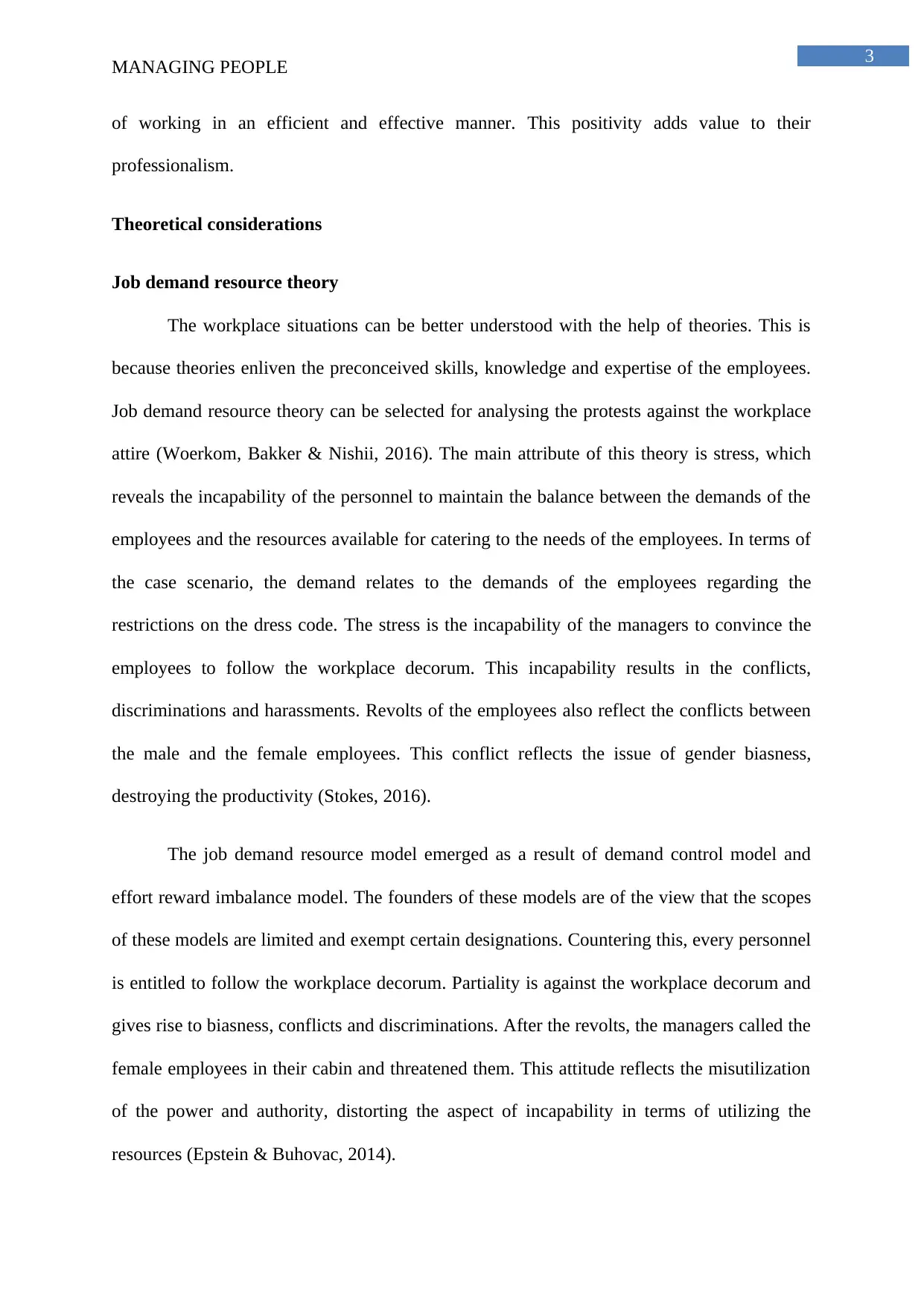
3
MANAGING PEOPLE
of working in an efficient and effective manner. This positivity adds value to their
professionalism.
Theoretical considerations
Job demand resource theory
The workplace situations can be better understood with the help of theories. This is
because theories enliven the preconceived skills, knowledge and expertise of the employees.
Job demand resource theory can be selected for analysing the protests against the workplace
attire (Woerkom, Bakker & Nishii, 2016). The main attribute of this theory is stress, which
reveals the incapability of the personnel to maintain the balance between the demands of the
employees and the resources available for catering to the needs of the employees. In terms of
the case scenario, the demand relates to the demands of the employees regarding the
restrictions on the dress code. The stress is the incapability of the managers to convince the
employees to follow the workplace decorum. This incapability results in the conflicts,
discriminations and harassments. Revolts of the employees also reflect the conflicts between
the male and the female employees. This conflict reflects the issue of gender biasness,
destroying the productivity (Stokes, 2016).
The job demand resource model emerged as a result of demand control model and
effort reward imbalance model. The founders of these models are of the view that the scopes
of these models are limited and exempt certain designations. Countering this, every personnel
is entitled to follow the workplace decorum. Partiality is against the workplace decorum and
gives rise to biasness, conflicts and discriminations. After the revolts, the managers called the
female employees in their cabin and threatened them. This attitude reflects the misutilization
of the power and authority, distorting the aspect of incapability in terms of utilizing the
resources (Epstein & Buhovac, 2014).
MANAGING PEOPLE
of working in an efficient and effective manner. This positivity adds value to their
professionalism.
Theoretical considerations
Job demand resource theory
The workplace situations can be better understood with the help of theories. This is
because theories enliven the preconceived skills, knowledge and expertise of the employees.
Job demand resource theory can be selected for analysing the protests against the workplace
attire (Woerkom, Bakker & Nishii, 2016). The main attribute of this theory is stress, which
reveals the incapability of the personnel to maintain the balance between the demands of the
employees and the resources available for catering to the needs of the employees. In terms of
the case scenario, the demand relates to the demands of the employees regarding the
restrictions on the dress code. The stress is the incapability of the managers to convince the
employees to follow the workplace decorum. This incapability results in the conflicts,
discriminations and harassments. Revolts of the employees also reflect the conflicts between
the male and the female employees. This conflict reflects the issue of gender biasness,
destroying the productivity (Stokes, 2016).
The job demand resource model emerged as a result of demand control model and
effort reward imbalance model. The founders of these models are of the view that the scopes
of these models are limited and exempt certain designations. Countering this, every personnel
is entitled to follow the workplace decorum. Partiality is against the workplace decorum and
gives rise to biasness, conflicts and discriminations. After the revolts, the managers called the
female employees in their cabin and threatened them. This attitude reflects the misutilization
of the power and authority, distorting the aspect of incapability in terms of utilizing the
resources (Epstein & Buhovac, 2014).
Secure Best Marks with AI Grader
Need help grading? Try our AI Grader for instant feedback on your assignments.
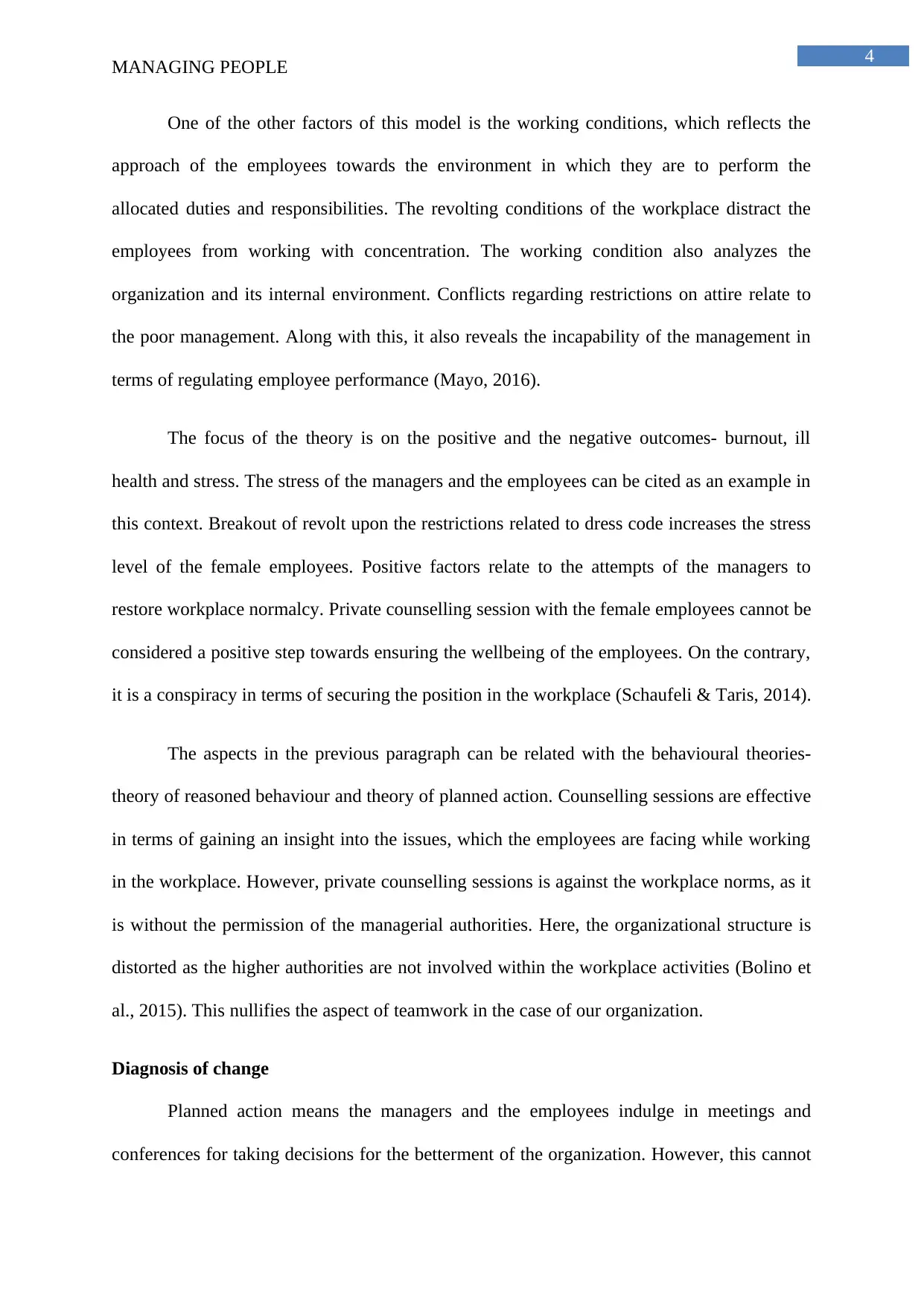
4
MANAGING PEOPLE
One of the other factors of this model is the working conditions, which reflects the
approach of the employees towards the environment in which they are to perform the
allocated duties and responsibilities. The revolting conditions of the workplace distract the
employees from working with concentration. The working condition also analyzes the
organization and its internal environment. Conflicts regarding restrictions on attire relate to
the poor management. Along with this, it also reveals the incapability of the management in
terms of regulating employee performance (Mayo, 2016).
The focus of the theory is on the positive and the negative outcomes- burnout, ill
health and stress. The stress of the managers and the employees can be cited as an example in
this context. Breakout of revolt upon the restrictions related to dress code increases the stress
level of the female employees. Positive factors relate to the attempts of the managers to
restore workplace normalcy. Private counselling session with the female employees cannot be
considered a positive step towards ensuring the wellbeing of the employees. On the contrary,
it is a conspiracy in terms of securing the position in the workplace (Schaufeli & Taris, 2014).
The aspects in the previous paragraph can be related with the behavioural theories-
theory of reasoned behaviour and theory of planned action. Counselling sessions are effective
in terms of gaining an insight into the issues, which the employees are facing while working
in the workplace. However, private counselling sessions is against the workplace norms, as it
is without the permission of the managerial authorities. Here, the organizational structure is
distorted as the higher authorities are not involved within the workplace activities (Bolino et
al., 2015). This nullifies the aspect of teamwork in the case of our organization.
Diagnosis of change
Planned action means the managers and the employees indulge in meetings and
conferences for taking decisions for the betterment of the organization. However, this cannot
MANAGING PEOPLE
One of the other factors of this model is the working conditions, which reflects the
approach of the employees towards the environment in which they are to perform the
allocated duties and responsibilities. The revolting conditions of the workplace distract the
employees from working with concentration. The working condition also analyzes the
organization and its internal environment. Conflicts regarding restrictions on attire relate to
the poor management. Along with this, it also reveals the incapability of the management in
terms of regulating employee performance (Mayo, 2016).
The focus of the theory is on the positive and the negative outcomes- burnout, ill
health and stress. The stress of the managers and the employees can be cited as an example in
this context. Breakout of revolt upon the restrictions related to dress code increases the stress
level of the female employees. Positive factors relate to the attempts of the managers to
restore workplace normalcy. Private counselling session with the female employees cannot be
considered a positive step towards ensuring the wellbeing of the employees. On the contrary,
it is a conspiracy in terms of securing the position in the workplace (Schaufeli & Taris, 2014).
The aspects in the previous paragraph can be related with the behavioural theories-
theory of reasoned behaviour and theory of planned action. Counselling sessions are effective
in terms of gaining an insight into the issues, which the employees are facing while working
in the workplace. However, private counselling sessions is against the workplace norms, as it
is without the permission of the managerial authorities. Here, the organizational structure is
distorted as the higher authorities are not involved within the workplace activities (Bolino et
al., 2015). This nullifies the aspect of teamwork in the case of our organization.
Diagnosis of change
Planned action means the managers and the employees indulge in meetings and
conferences for taking decisions for the betterment of the organization. However, this cannot
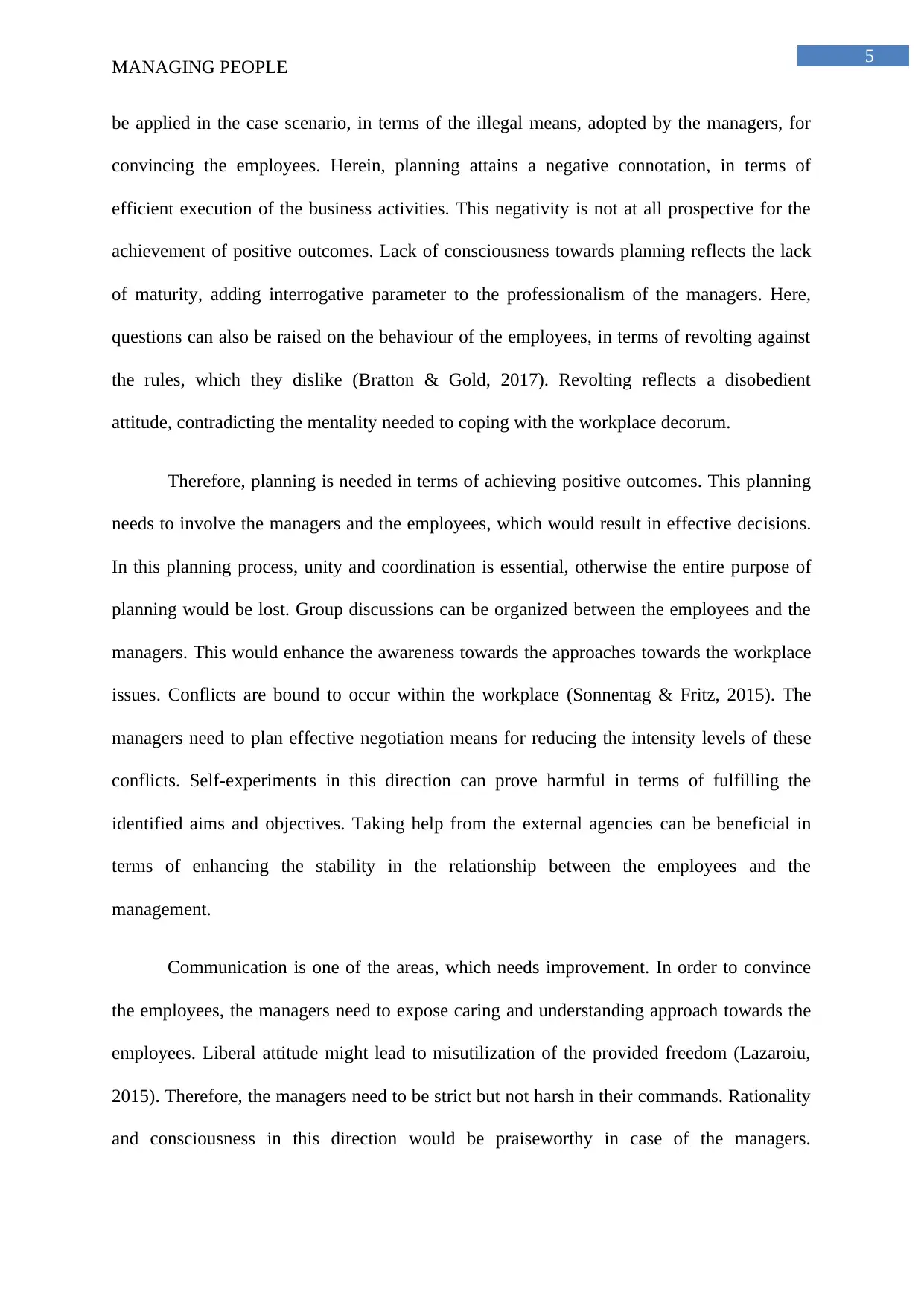
5
MANAGING PEOPLE
be applied in the case scenario, in terms of the illegal means, adopted by the managers, for
convincing the employees. Herein, planning attains a negative connotation, in terms of
efficient execution of the business activities. This negativity is not at all prospective for the
achievement of positive outcomes. Lack of consciousness towards planning reflects the lack
of maturity, adding interrogative parameter to the professionalism of the managers. Here,
questions can also be raised on the behaviour of the employees, in terms of revolting against
the rules, which they dislike (Bratton & Gold, 2017). Revolting reflects a disobedient
attitude, contradicting the mentality needed to coping with the workplace decorum.
Therefore, planning is needed in terms of achieving positive outcomes. This planning
needs to involve the managers and the employees, which would result in effective decisions.
In this planning process, unity and coordination is essential, otherwise the entire purpose of
planning would be lost. Group discussions can be organized between the employees and the
managers. This would enhance the awareness towards the approaches towards the workplace
issues. Conflicts are bound to occur within the workplace (Sonnentag & Fritz, 2015). The
managers need to plan effective negotiation means for reducing the intensity levels of these
conflicts. Self-experiments in this direction can prove harmful in terms of fulfilling the
identified aims and objectives. Taking help from the external agencies can be beneficial in
terms of enhancing the stability in the relationship between the employees and the
management.
Communication is one of the areas, which needs improvement. In order to convince
the employees, the managers need to expose caring and understanding approach towards the
employees. Liberal attitude might lead to misutilization of the provided freedom (Lazaroiu,
2015). Therefore, the managers need to be strict but not harsh in their commands. Rationality
and consciousness in this direction would be praiseworthy in case of the managers.
MANAGING PEOPLE
be applied in the case scenario, in terms of the illegal means, adopted by the managers, for
convincing the employees. Herein, planning attains a negative connotation, in terms of
efficient execution of the business activities. This negativity is not at all prospective for the
achievement of positive outcomes. Lack of consciousness towards planning reflects the lack
of maturity, adding interrogative parameter to the professionalism of the managers. Here,
questions can also be raised on the behaviour of the employees, in terms of revolting against
the rules, which they dislike (Bratton & Gold, 2017). Revolting reflects a disobedient
attitude, contradicting the mentality needed to coping with the workplace decorum.
Therefore, planning is needed in terms of achieving positive outcomes. This planning
needs to involve the managers and the employees, which would result in effective decisions.
In this planning process, unity and coordination is essential, otherwise the entire purpose of
planning would be lost. Group discussions can be organized between the employees and the
managers. This would enhance the awareness towards the approaches towards the workplace
issues. Conflicts are bound to occur within the workplace (Sonnentag & Fritz, 2015). The
managers need to plan effective negotiation means for reducing the intensity levels of these
conflicts. Self-experiments in this direction can prove harmful in terms of fulfilling the
identified aims and objectives. Taking help from the external agencies can be beneficial in
terms of enhancing the stability in the relationship between the employees and the
management.
Communication is one of the areas, which needs improvement. In order to convince
the employees, the managers need to expose caring and understanding approach towards the
employees. Liberal attitude might lead to misutilization of the provided freedom (Lazaroiu,
2015). Therefore, the managers need to be strict but not harsh in their commands. Rationality
and consciousness in this direction would be praiseworthy in case of the managers.
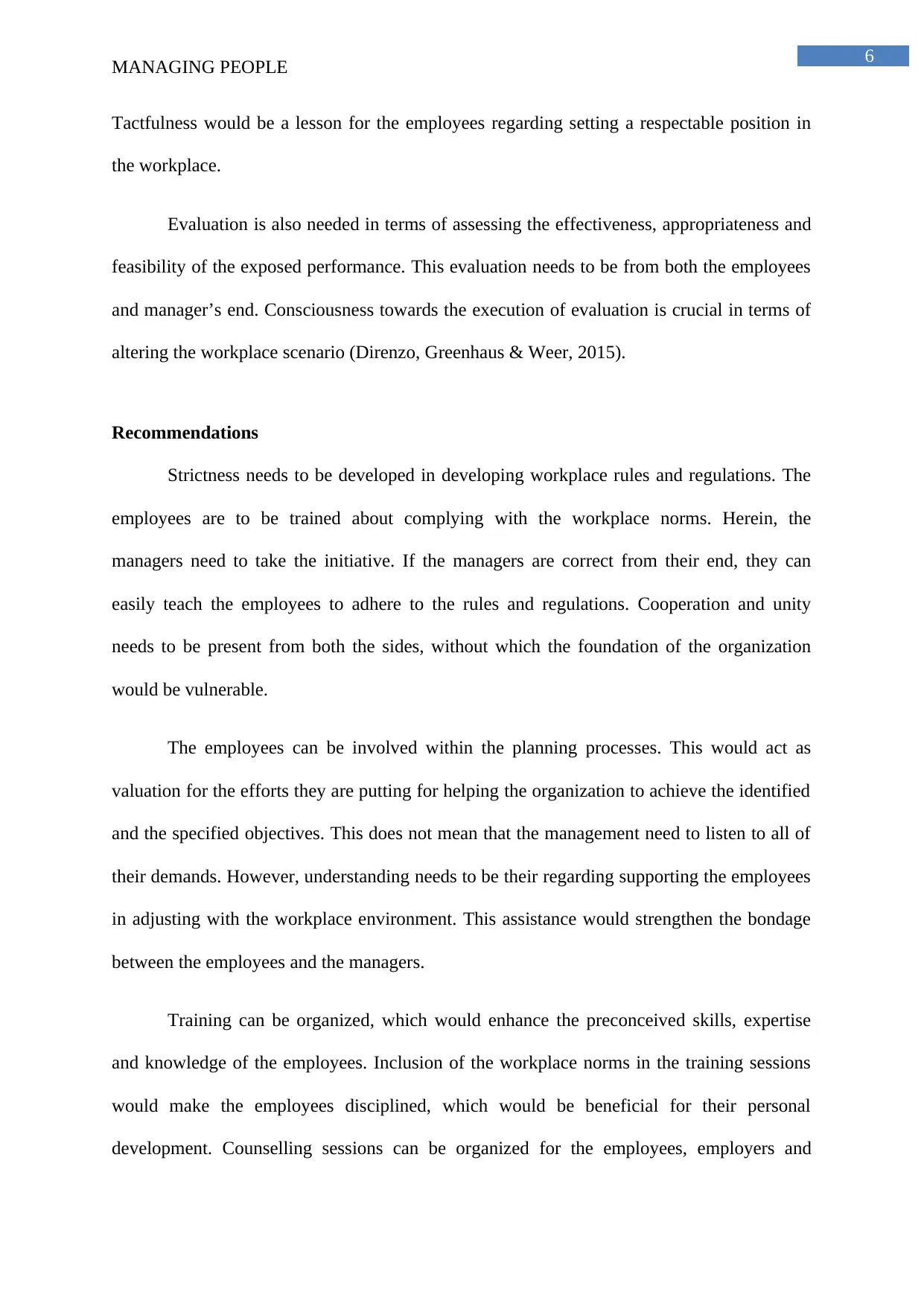
6
MANAGING PEOPLE
Tactfulness would be a lesson for the employees regarding setting a respectable position in
the workplace.
Evaluation is also needed in terms of assessing the effectiveness, appropriateness and
feasibility of the exposed performance. This evaluation needs to be from both the employees
and manager’s end. Consciousness towards the execution of evaluation is crucial in terms of
altering the workplace scenario (Direnzo, Greenhaus & Weer, 2015).
Recommendations
Strictness needs to be developed in developing workplace rules and regulations. The
employees are to be trained about complying with the workplace norms. Herein, the
managers need to take the initiative. If the managers are correct from their end, they can
easily teach the employees to adhere to the rules and regulations. Cooperation and unity
needs to be present from both the sides, without which the foundation of the organization
would be vulnerable.
The employees can be involved within the planning processes. This would act as
valuation for the efforts they are putting for helping the organization to achieve the identified
and the specified objectives. This does not mean that the management need to listen to all of
their demands. However, understanding needs to be their regarding supporting the employees
in adjusting with the workplace environment. This assistance would strengthen the bondage
between the employees and the managers.
Training can be organized, which would enhance the preconceived skills, expertise
and knowledge of the employees. Inclusion of the workplace norms in the training sessions
would make the employees disciplined, which would be beneficial for their personal
development. Counselling sessions can be organized for the employees, employers and
MANAGING PEOPLE
Tactfulness would be a lesson for the employees regarding setting a respectable position in
the workplace.
Evaluation is also needed in terms of assessing the effectiveness, appropriateness and
feasibility of the exposed performance. This evaluation needs to be from both the employees
and manager’s end. Consciousness towards the execution of evaluation is crucial in terms of
altering the workplace scenario (Direnzo, Greenhaus & Weer, 2015).
Recommendations
Strictness needs to be developed in developing workplace rules and regulations. The
employees are to be trained about complying with the workplace norms. Herein, the
managers need to take the initiative. If the managers are correct from their end, they can
easily teach the employees to adhere to the rules and regulations. Cooperation and unity
needs to be present from both the sides, without which the foundation of the organization
would be vulnerable.
The employees can be involved within the planning processes. This would act as
valuation for the efforts they are putting for helping the organization to achieve the identified
and the specified objectives. This does not mean that the management need to listen to all of
their demands. However, understanding needs to be their regarding supporting the employees
in adjusting with the workplace environment. This assistance would strengthen the bondage
between the employees and the managers.
Training can be organized, which would enhance the preconceived skills, expertise
and knowledge of the employees. Inclusion of the workplace norms in the training sessions
would make the employees disciplined, which would be beneficial for their personal
development. Counselling sessions can be organized for the employees, employers and
Paraphrase This Document
Need a fresh take? Get an instant paraphrase of this document with our AI Paraphraser
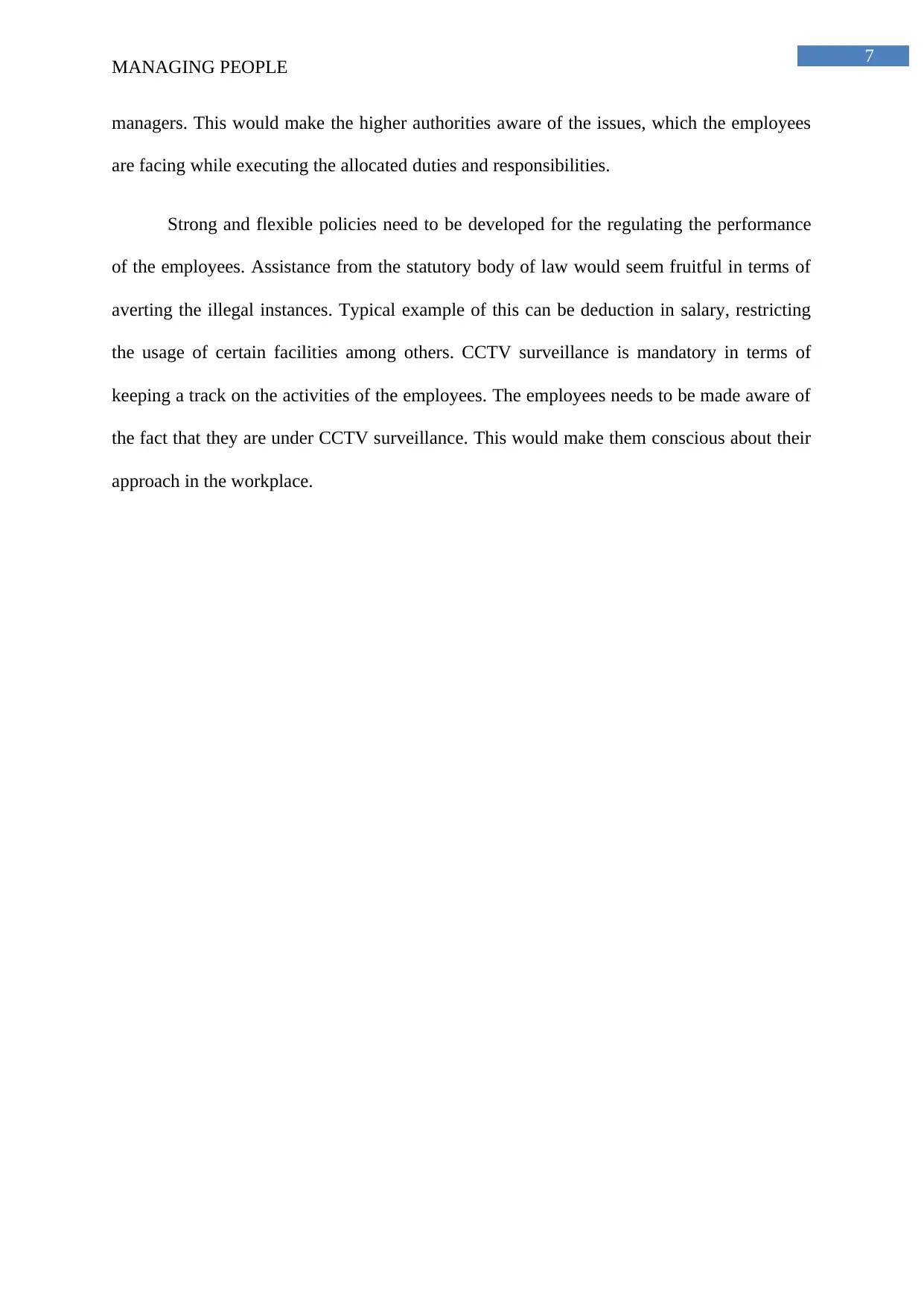
7
MANAGING PEOPLE
managers. This would make the higher authorities aware of the issues, which the employees
are facing while executing the allocated duties and responsibilities.
Strong and flexible policies need to be developed for the regulating the performance
of the employees. Assistance from the statutory body of law would seem fruitful in terms of
averting the illegal instances. Typical example of this can be deduction in salary, restricting
the usage of certain facilities among others. CCTV surveillance is mandatory in terms of
keeping a track on the activities of the employees. The employees needs to be made aware of
the fact that they are under CCTV surveillance. This would make them conscious about their
approach in the workplace.
MANAGING PEOPLE
managers. This would make the higher authorities aware of the issues, which the employees
are facing while executing the allocated duties and responsibilities.
Strong and flexible policies need to be developed for the regulating the performance
of the employees. Assistance from the statutory body of law would seem fruitful in terms of
averting the illegal instances. Typical example of this can be deduction in salary, restricting
the usage of certain facilities among others. CCTV surveillance is mandatory in terms of
keeping a track on the activities of the employees. The employees needs to be made aware of
the fact that they are under CCTV surveillance. This would make them conscious about their
approach in the workplace.
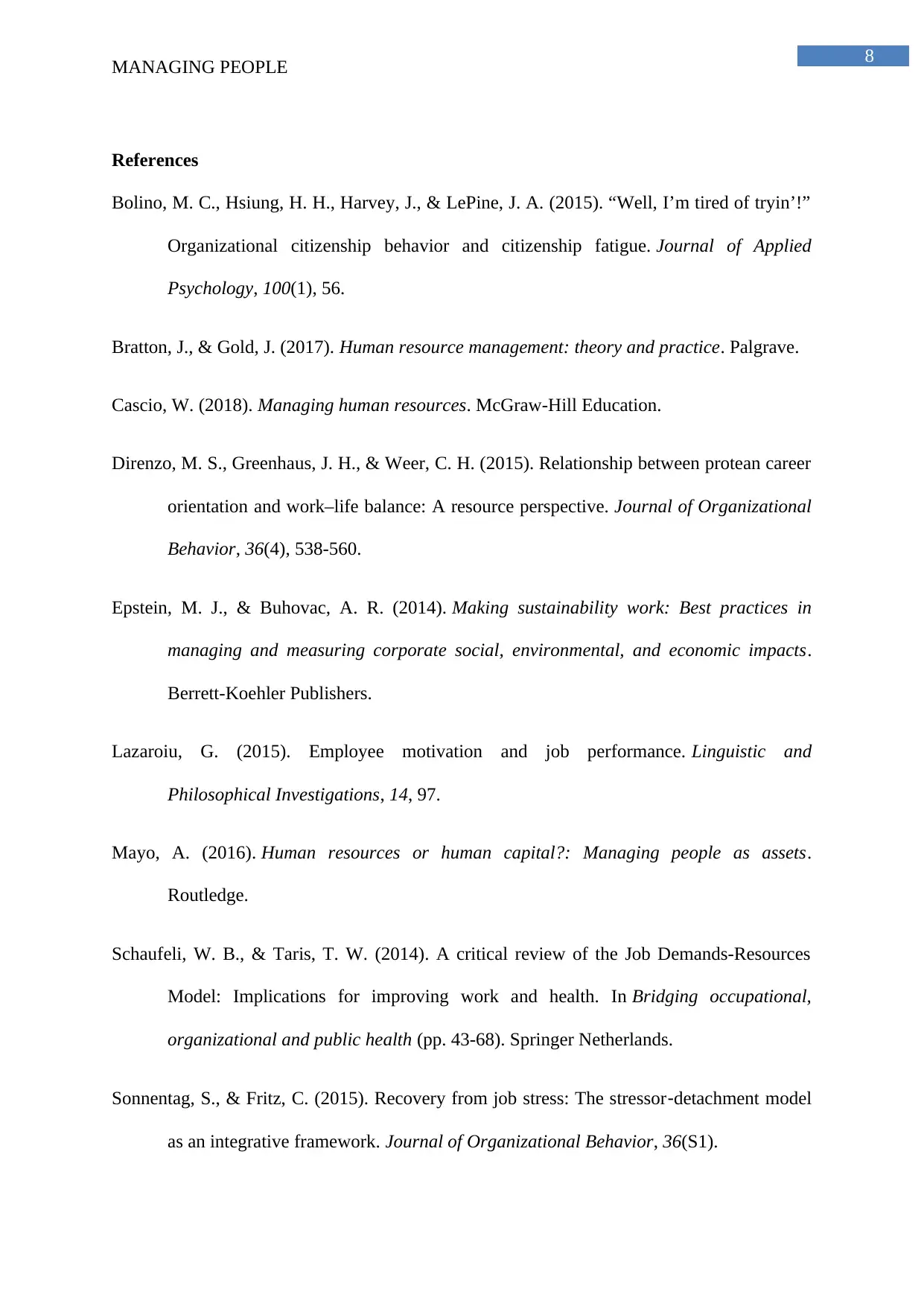
8
MANAGING PEOPLE
References
Bolino, M. C., Hsiung, H. H., Harvey, J., & LePine, J. A. (2015). “Well, I’m tired of tryin’!”
Organizational citizenship behavior and citizenship fatigue. Journal of Applied
Psychology, 100(1), 56.
Bratton, J., & Gold, J. (2017). Human resource management: theory and practice. Palgrave.
Cascio, W. (2018). Managing human resources. McGraw-Hill Education.
Direnzo, M. S., Greenhaus, J. H., & Weer, C. H. (2015). Relationship between protean career
orientation and work–life balance: A resource perspective. Journal of Organizational
Behavior, 36(4), 538-560.
Epstein, M. J., & Buhovac, A. R. (2014). Making sustainability work: Best practices in
managing and measuring corporate social, environmental, and economic impacts.
Berrett-Koehler Publishers.
Lazaroiu, G. (2015). Employee motivation and job performance. Linguistic and
Philosophical Investigations, 14, 97.
Mayo, A. (2016). Human resources or human capital?: Managing people as assets.
Routledge.
Schaufeli, W. B., & Taris, T. W. (2014). A critical review of the Job Demands-Resources
Model: Implications for improving work and health. In Bridging occupational,
organizational and public health (pp. 43-68). Springer Netherlands.
Sonnentag, S., & Fritz, C. (2015). Recovery from job stress: The stressor‐detachment model
as an integrative framework. Journal of Organizational Behavior, 36(S1).
MANAGING PEOPLE
References
Bolino, M. C., Hsiung, H. H., Harvey, J., & LePine, J. A. (2015). “Well, I’m tired of tryin’!”
Organizational citizenship behavior and citizenship fatigue. Journal of Applied
Psychology, 100(1), 56.
Bratton, J., & Gold, J. (2017). Human resource management: theory and practice. Palgrave.
Cascio, W. (2018). Managing human resources. McGraw-Hill Education.
Direnzo, M. S., Greenhaus, J. H., & Weer, C. H. (2015). Relationship between protean career
orientation and work–life balance: A resource perspective. Journal of Organizational
Behavior, 36(4), 538-560.
Epstein, M. J., & Buhovac, A. R. (2014). Making sustainability work: Best practices in
managing and measuring corporate social, environmental, and economic impacts.
Berrett-Koehler Publishers.
Lazaroiu, G. (2015). Employee motivation and job performance. Linguistic and
Philosophical Investigations, 14, 97.
Mayo, A. (2016). Human resources or human capital?: Managing people as assets.
Routledge.
Schaufeli, W. B., & Taris, T. W. (2014). A critical review of the Job Demands-Resources
Model: Implications for improving work and health. In Bridging occupational,
organizational and public health (pp. 43-68). Springer Netherlands.
Sonnentag, S., & Fritz, C. (2015). Recovery from job stress: The stressor‐detachment model
as an integrative framework. Journal of Organizational Behavior, 36(S1).
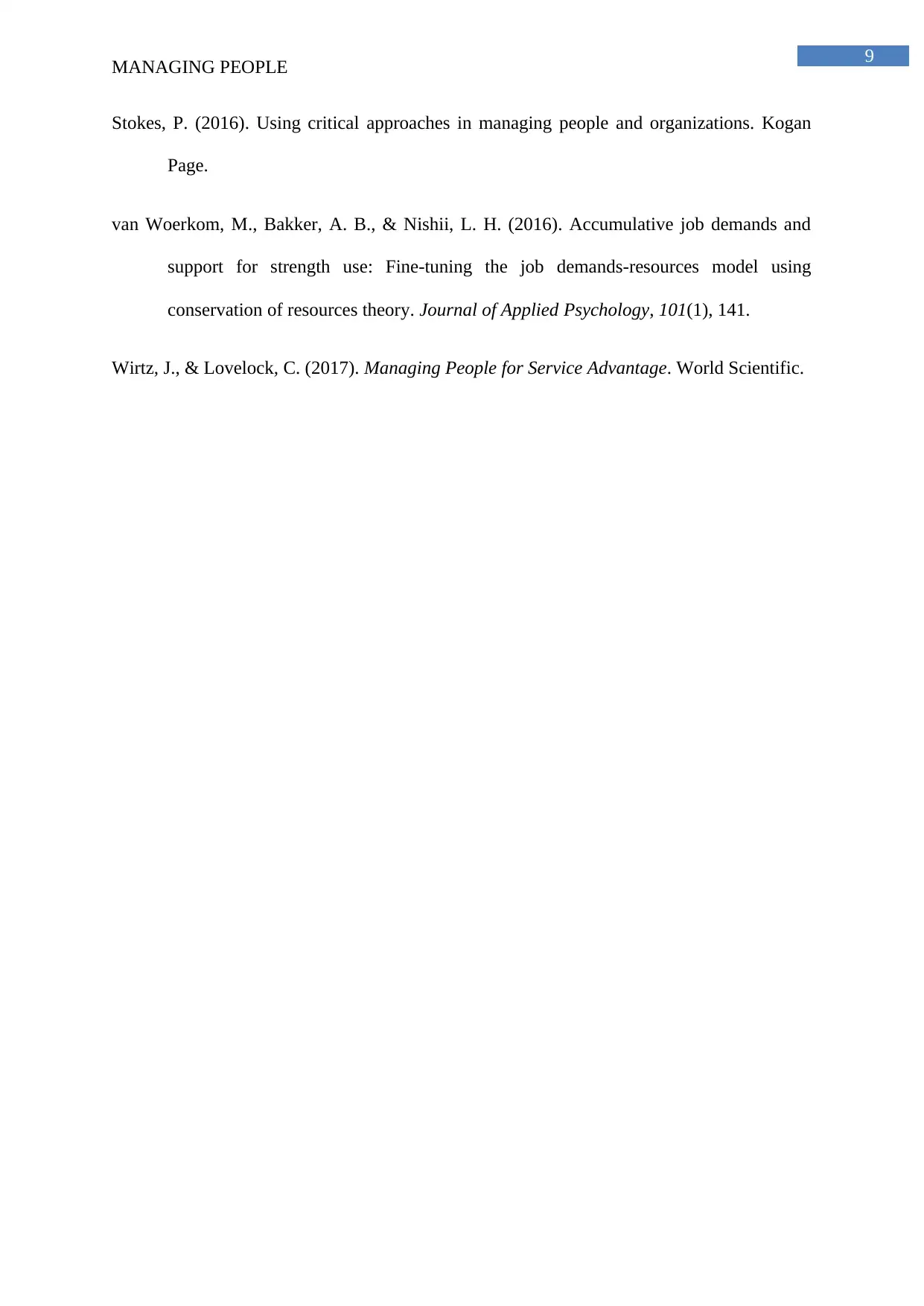
9
MANAGING PEOPLE
Stokes, P. (2016). Using critical approaches in managing people and organizations. Kogan
Page.
van Woerkom, M., Bakker, A. B., & Nishii, L. H. (2016). Accumulative job demands and
support for strength use: Fine-tuning the job demands-resources model using
conservation of resources theory. Journal of Applied Psychology, 101(1), 141.
Wirtz, J., & Lovelock, C. (2017). Managing People for Service Advantage. World Scientific.
MANAGING PEOPLE
Stokes, P. (2016). Using critical approaches in managing people and organizations. Kogan
Page.
van Woerkom, M., Bakker, A. B., & Nishii, L. H. (2016). Accumulative job demands and
support for strength use: Fine-tuning the job demands-resources model using
conservation of resources theory. Journal of Applied Psychology, 101(1), 141.
Wirtz, J., & Lovelock, C. (2017). Managing People for Service Advantage. World Scientific.
1 out of 10
Related Documents
Your All-in-One AI-Powered Toolkit for Academic Success.
+13062052269
info@desklib.com
Available 24*7 on WhatsApp / Email
![[object Object]](/_next/static/media/star-bottom.7253800d.svg)
Unlock your academic potential
© 2024 | Zucol Services PVT LTD | All rights reserved.
